#family tree dna
Text
Doctor Who family scheme
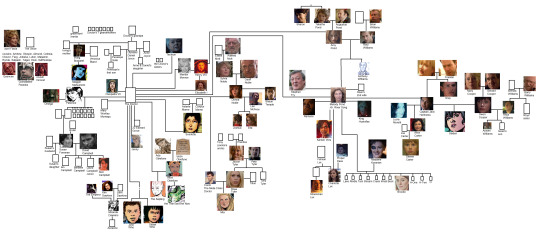
I'm still working on this, but it's an attempt at a family tree of the doctor. (Or rather a web of family trees surrounding them)
It is of course pretty difficult and chaotic per definition
#doctor who#making this family tree entails choices like: is this sentient life created by a bit of this person's dna technically their offspring?#the doctor#tecteun#timeless child#river song#rose tyler#metacrisis doctor#captain jack harkness#jackie tyler#the doctor's daughter#donna noble#amy pond#rory williams#gwen cooper#torchwood#susan foreman#doctor who family#the doctor's fam#doctor who fandom#whovian#dr who#tardis#nuwho#new who
238 notes
·
View notes
Text
Despite figuring out all the ways that certain cats are related, I don't actually really care about incest in the Warriors series. I just like figuring out the family tree because it's fun.
#it's inevitable in small communities for distant cousins to get into relationships#my own great-grandparents were 3rd cousins once removed (only sharing 0.391% of their DNA) which was fine!#some of y'all dont realize how little DNA is shared once you get past 3rd cousins (which share 0.781% of their DNA)#4th cousins share 0.195% DNA. 5th cousins share 0.049% DNA. 6th cousins share 0.012% DNA. 7th cousins share 0.003% DNA (less than 0.01%!)#and just for reference: 2nd cousins share 3.125% of their DNA and 1st cousins share 12.5%#apparently people are now being ableist over moonpaw? over a non-existent kittycat??#making fun of the erins' poor family tree planning skills is not the same as making fun of disabled ppl and victims of incest#or calling for eugenics (!!) against people you deem undesirable#put your energy into helping actual victims instead#moonpaw#warrior cats#warriors#wc#harbor's posts
33 notes
·
View notes
Note
Is there any chance you could make a web weaving of wanting to be a better parent than one’s own? Like a protective individual wanting to spite a bloodline of pain to foster love and care to their own child? To be better that one’s own parents? I think a web weaving of this would be gorgeous!



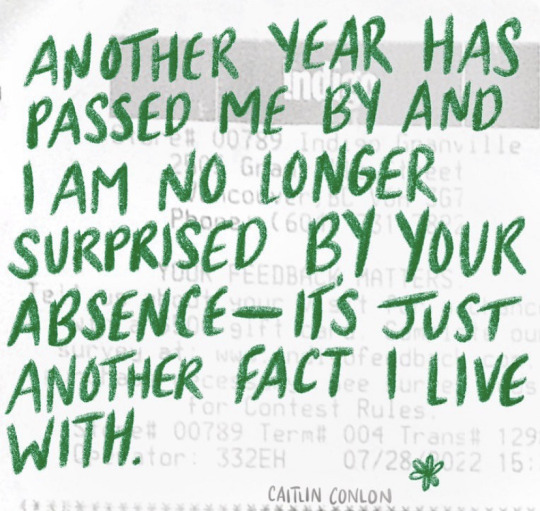




Ethel Cain Family Tree (Intro) / The Oh Hellos Dear Wormwood / Emily Brontë Healthcliff / Caitlin Conlon (@/cgcpoems on instagram) / Lia Marie Johnson DNA / Nicola Yoon The Sun Is Also a Star / Daniel Jamie Williams Dear Mother... / Marina & The Diamonds The Family Jewels
#a lot of these are song lyrics that's my bad lol#on parents#on growing up#on childhood#on loneliness#on being left behind#web weave#web weaving#literature#ethel cain#family tree#the oh hellos#dear wormwood#emily bronte#healthcliff#caitlin conlon#lia marie johnson#dna#nicola yoon#the sun is also a star#daniel jamie williams#dear mother#marina & the diamonds#the family jewels#poem#spilled poetry#spilled ink#writing#spilled thoughts#words
221 notes
·
View notes
Text
You guys should see the family tree reference chart I have to keep track of the ancestors from the Readers Florent AND Baratheon heritage, to keep track of Robbs heritage through the Starks amd Tullys, and Jons heritage through the Starks and Targaryeans.
Google probably thinks I am some expert researcher in the field of generational bloodlines and incest considering how often I have to look up what relation a distant relative makes someone to you and what thats even called.
#i think i understand this series of bloodlines more then grrm does#i shouldnt need to know who the readers goddamn sixth cousin is but i do#like#what the fuck is a sixth cousin thats a fucking stranger im not playing this game anymore#im not inviting someones fourth cousin to the family reunion get out of there we share literally like .001% dna#its comical the family tree charts i have#as soon as i realized that technically i could legitimately connect Jorah fucking Mormont to the readers family tree#i was like fuck no get out you weird creep you are uninvited from family brunch
9 notes
·
View notes
Note
Did you hear about the Pilar barbie situation on TikTok where it was a white women lying about being Romani and created a whole make-up business off the lie 😭
GIRL omg 💀💀 gossiping about Pilar is one of my favourite activities...
She has a lot of lore so I'm going to walk you through all I can remember
For the people who don't know her, Pilar was an American tiktoker who made videos about Romani issues (this is the only remaining picture of her I found on tiktok)
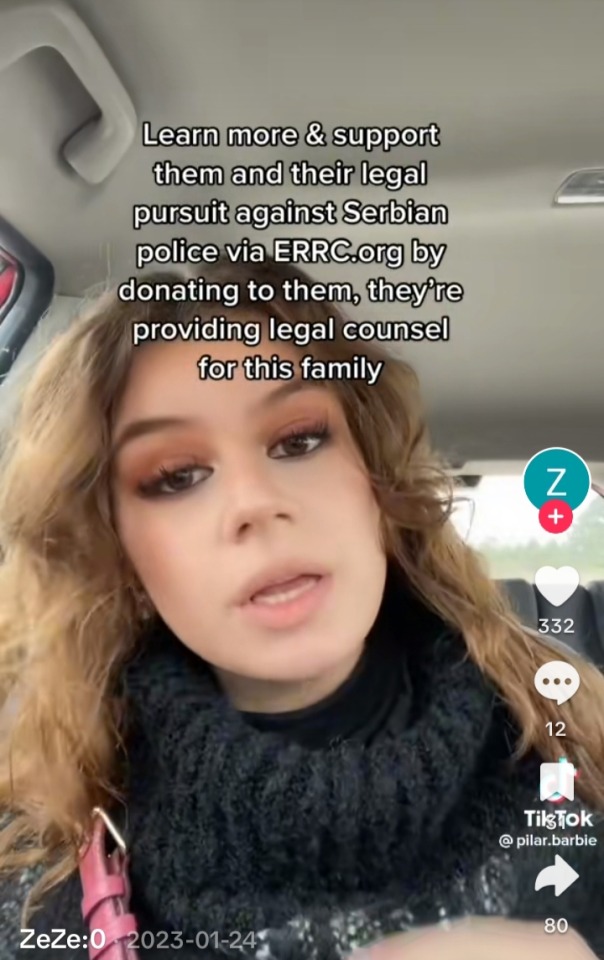
From what I remember, she was already there in 2020 during COVID times when I became active on Romani internet. I don't even remember when she got really popular, it must have happened gradually or something but she was one of the biggest Romani 'internet activists' alongside Florian and Brooke (in the early days).
Sometimes she also dressed more 'traditional'

which... really just looks like she was putting on a costume. anyway I don't have more recent pictures from her tiktoks as she suspended her account but the way she wore a headscarf and golden jewellery to try and emulate being Romani was already pretty messed up and unnecessary, as a lot of Romani women dont wear either of these things in the first place
I don't remember what group she was originally claiming to be from, but that's the point, she kept changing it. Except that she did so over a very slow period of time and by making only vague references about her heritage so it was hard to catch on. Anyway, over the past 4 years I have heard her say she was:
Russian Romani
Polish Romani
Crimean Romani
Gitana/Spanish Romani
Sinti
Manush, to be even more specific
Mixed Eastern European Romani + Manush
And that is all I specifically remember but I wouldn't be surprised if she also had a kalderash or lovari arc at some point 💀 anyway, after a while I started noticing things weren't adding up and her heritage was very vague and that was weird. Not to be mean, but she is also American, and I always feel way, way more cautious when it comes to American Roma than European Roma, Romani racefakers are almost always American because no European in their right mind would think it's cool to pretend to be romani 😭😭
Anyway, what really made it for me was the stuff she used to say on tiktok. Some of it was just blatantly not true. I almost lost my mind during her Sinti arc because she said stuff like "Sara e Kali isn't a big religious figure for Sinti people", "Sara e Kali isn't a catholic romani figure", and then she also pretended to have ties to some famous Sinti people when i know for a fact that is not possible... But I can't say more about that because that would be too doxx-y... She also said some more bs about Sinti people and I corrected her in the comments and she tried to follow me and it was so cringe
Then I also knew she was toxic because she would harass Romani women on tiktok and I remember at least one instance when she insulted a European Romani woman by saying, "you claim to be Romani but you dress like a hoe, you're just a gadji because Romani women respect ourselves by covering up"....
Two other things that didn't sit right with me was her clntent. She would talk a lot about anti Roma racism in Europe, which was great, she would talk about news no one else talked about. But she had a very guilt-trippy and angry way to talk about it that made it look like she was overdoing it and mocking the way antiracist activists talk, just to get engagement. It didn't feel genuine. And also, she would put ads for her make up brand and Cosplays of her as Wanda Maximoff between tiktoks about pogroms and police brutality. It all looked like a scam and like she was doing some traumaporn just for people to buy her stuff
And she also bullied Brooke so hard that she never came back on Tiktok, even though she (Brooke) had been the OG Romani tiktoker, had even been featured in Romea (a Romani newspaper), and was genuinely half Romani. And why? Because she is white passing? That's stupid, Pilar was allegedly white passing herself
(the way so many Romani tiktokers turned their back against Brooke was super disgusting btw, I don't know her personally but from what I've heard she is a very nice person)
Anyway, by 2022 I knew for sure Pilar was lying. That year I got in touch with other Romani girls and women online and we discussed it and they also all knew that Pilat was lying. Her being a racefaker was pretty much an open secret, at least among (chronically) online Romani people. Except that none of us could call her out, because she was very popular and extremely toxic. I can't even tell you how toxic she was. She had a circle made up of other American Romani women and they bullied tons of Romani people online, and guess what these romani people had in common!
Most of them were women
Most of them had a complicated family history
A lot of them were white passing (really tho, being white passing seems to be a problem ONLY when you are a woman. white passing Romani men never receive any hate)
A lot of them were LGB
And these American Roma bullied them, made a lot of them suicidal (seriously, I've heard several accounts of Pilar's bullying victims becoming suicidal), because they allegedly weren't 'romani enough'.
So, obviously, neither me nor any of my friend could call her out because we weren't nowhere as popular and we were all LGB romnia.
But then came FLORIAN. Literally the only person who could put a stop to her shenanigans. Ngl, I think only Florian, a straight, American Romani man with a big platform could have stopped her. And I am so glad he did, because she really made being Romani on the internet very stressful. I was so scared she would come to Tumblr one day lmao. Anyway, I have a lot of bones to pick with Florian but that was his biggest W. Here is his tiktok btw:
#Everything about her was faaake omg#when Florian's tiktok call out dropped I screamed#the evil is defeated etc#So ironic that those bullies were AMERICAN too...#American Roma don't get an iota of the racism Sinti and Roma face in Europe#but they still have the nerve to pretend they can say who is Roma and who isn't??#also her Romaness accent was so bad#And I remember when her DNA test leaked and her family tree was all Spanish people lmao#but she got that account suspended#asks#Anon#Pilar
8 notes
·
View notes
Text

Snapcube sly cooper voice: Apparently I'm Every Race
#barkbark#yeah i gave the government my dna now they will clone me or something probably im sure#i was curious tho#also NOT MY FAMILY TREE AND THE SLAVE TRADE OVERLAPPING OH NO
8 notes
·
View notes
Text
Tamberlane and the thorny issue of adoption in roots work

Clearly, there are different types of roots, beyond what the teacher in these panels from Tamberlane is telling her. This is NOT what you tell someone about their roots. Teacher, you are doing this all wrong!
Reprinted from my Genealogy in Popular Culture WordPress blog. Originally published on March 8, 2021.
One of my favorite ongoing webcomics, Tamberlane, hits you right in the face with an issue which often faces genealogists: adoption. Tamberlane, the story's protagonist is told by her teacher, Ms. Callie. that they will be learning about "their roots." [1] This worries her, as she first thinks that it means she literally has roots growing out of her, and later when she learns that roots make you for "who you are." She is concerned because she's from the far-off place known as "Abroad" but her friends comfort her, reminding her that her roots are in Treehollow with the rest of them because she lives there. Cur later challenges Ms. Callie, asking about students who don't know their roots and starts making a scene. Later, the teacher is flustered and doesn't know how to answer questions about "Abroad," with Jentzen kicked out of the classroom as a result, just because he asked a question! This becomes a plot point later in the series, as Cur blames Tamberlane for Jentzen getting fired, even though it isn't Tamberlane's fault, leading Piper to get in a fight with Cur. [2] As it turns out, not even Tamberlane's guardian, Belfry, can adequately explain "Abroad" to her. [3]
Ms. Callie was wrong about roots. As Becks Kobel, a death positive genealogist [4] wrote in October 2017, "we are placed within families, whether biologically or through adoption, that have a long history with all sorts of experiences." Roots are not only based in your blood, but are wider ranging than that, including your chosen family, those you surround yourselves with, and your circumstances. They can be your roots. There are even some Italian surnames, like Esposito, which were given to children in Italy who were given up by their parents or were adopted! At the same time, a surname may be assumed because of an "unofficial adoption, taking on a stepfather’s surname and so on" as was the case with one of my ancestors, Robert B. Mills II (originally Robert Barnabas Packard). Some genealogists even warn about not being "lured into sympathy research via an adoption story" while others note that DNA tests can be helpful for those with ancestors who were adopted or those looking for their birth parents. Sure, you could say that the "standard" family tree wasn't made for adoption, but that doesn't mean it is invalid, as adoptees can be heirs to estate from time to time. Some stick with the so-called standard tree, as "Geni cannot record adoptions" but that doesn't mean that records of it doesn't exist. [5] Russian genealogist Vera Miller talked about this:
Many adoptees become curious about their birth families and hopeful their questions about their separations from their families will be answered. The challenges of some adoptees from the Russian-speaking world is facing that their Russian language skills disappeared or were never developed. Thanks to the Internet, these adoptees can find their families with just as much success as adoptees from the English-speaking world.
That brings me back to Tamberlane. She was, at the beginning of the comic, found in the woods by the citizens of Treehollow and while she isn't always good with communicating verbally, she knows a bit of pidgin Trissol (Silver Sage Sign Language). She calls herself "Tamberlane" when meeting Belfry for the first time in Chapter 1, with Belfry wondering where her parents are, and who left her there. As such, the other stuff I said about adoption isn't applicable here, although it is still worth noting. Hopefully, in the future, this is explored more in the webcomic.
© 2021-2023 Burkely Hermann. All rights reserved.
Notes
[1] Caytlin Vilbrandt, Tamberlane, Chapter 4, Pages 181-190, Issue 15 on WEBTOON, Jan. 2, 2020.
[2] Caytlin Vilbrandt, Tamberlane, Chapter 4, Pages 191-199, Issue 16 on WEBTOON, Jan. 2, 2020.
[3] Caytlin Vilbrandt, Tamberlane, Chapter 4, Page 207, Issue 22 on WEBTOON, Feb. 10, 2020; Caytlin Vilbrandt, Tamberlane, Chapter 4, Page 208, Issue 23 on WEBTOON, Feb. 19, 2020
[4] She left Twitter some time ago and now occasionally posts on Instagram. So, she is still active (perhaps more on Facebook), but not in the way she used to be on social media. And that's ok.
[5] In a related note, a Puerto Rican genealogist Teresa Vega, argued that with "Ancestry doing away with <8 cM DNA matches," it would negatively impact Black and indigenous descendants, saying they should "seriously consider that they are preventing family reunification not only due to slavery, but also due to adoption, genocide, famine, etc."
#tamberlane#webcomics#webtoon#roots work#genealogy#family history#pop culture#adoption#chosen family#trees#humanity#dna#dna testing#reviews
27 notes
·
View notes
Text
“So, are they related?”
“Well, they both show up next to each other on these family tree documents, but it doesn’t say if they’re siblings or cousins or anything else. And they aren’t clones either. The genealogy and DNA tests do confirm SOME sort of relation between them. We just don’t know what.”
“Okay? Have we at least tried asking them? If they’re related and how I mean. No?”
“We have on several occasions but the answers they gave were insufferably vague and maddeningly unhelpful. On one occasion one of them says yes, followed by no, and the other one says no meaning yes.”
“What….”
“I know. It’s baffling.”
“So what do we say?”
“Their latest answer which they both agreed on was yes but no but yes but no but yes but no but yes.”
“….so what does that mean?”
“I’m not sure. I’m having it sent for analysis with our cryptographers and code breakers. They said something about applying mathematics and patterns, not my field admittedly. We should hopefully get an answer out of them.”
“Right…”
#dougie rambles#personal stuff#dna#family tree#genealogy#relatives#relation#ambiguously related#vagueness#cryptic#unhelpful#esoteric jargon#well yes but actually no#yes but no#cryptography#code breaking#mathematics#analysis#madness#my poor attempt at a joke#what#no context#this sounded funnier in my head#idk#shitpost#unreality
2 notes
·
View notes
Text
Jose Mier, Sun Valley, CA and DNA
Unraveling Ancestral Mysteries: DNA Testing for Genealogy
Jose Mier, amateur genealogist in Sun Valley, CA searches for others with the same name. As an aside, some of this research is actual genealogy. Today he delves into powerful tools that can aid that research. One is direct-to-consumer DNA testing, one of the tools listed in an article on the Family Tree Magazine website.
DNA test site…

View On WordPress
2 notes
·
View notes
Text
How To Start Your Family Search, Part 1.
You could start your family history search with doing a DNA test. But I suggest starting with writing down what you already know about family members from the past. The DNA test wait time is six to eight weeks so in that time ask others in your family what they know or remember; parents, if still living, and siblings. And don’t forget asking aunts and uncles and cousins. Their stories will help…

View On WordPress
#blogging#DNA#Family#family tree#Genealogy#J.D. Holiday#records#Research#Starting family history#vital records
8 notes
·
View notes
Text
IFLScience: Largest Ever Family Tree Reveals Origins Of All Humanity
Almost all of us, if we go back far enough in our family trees, come from somewhere else. Maybe it was your mom or dad; maybe it was a distant ancestor who lived more than twelve thousand years ago, but eventually, you’re going to find someone, at some point, who left their homeland in search of a better life.

19.4N, 33.7E - the origins of everyone alive today. Image: Google Maps/IFLS
Almost all of us, if we go back far enough in our family trees, come from somewhere else. Maybe it was your mom or dad; maybe it was a distant ancestor who lived more than twelve thousand years ago, but eventually, you’re going to find someone, at some point, who left their homeland in search of a better life.
Unless, that is, you happen to live here. It’s a spot of desert in the north-east of Sudan, not far from the Nile river, and according to an ambitious new analysis by researchers at the University of Oxford’s Big Data Institute, it may be the ancestral home of everybody alive today.
“Essentially, we are reconstructing the genomes of our ancestors and using them to form a vast network of relationships,” explained Dr Anthony Wilder Wohns, lead author of the study published today in the journal Science.
“We can then estimate when and where these ancestors lived,” said Wohns.
We’re likely all familiar with the idea of tracing family trees using DNA and genomics analysis these days – not only are they a commercially-available relationship ender, but they’ve also been used to solve quite a few murders in the past few years.
But for some researchers, the dream has always been to take it global.
“We have basically built a huge family tree, a genealogy for all of humanity,” said evolutionary geneticist and principal author Dr Yan Wong. “This genealogy allows us to see how every person’s genetic sequence relates to every other, along all the points of the genome.”
“Huge” is right: using data from eight different human genome databases, the researchers were able to create a network of almost 27 million ancestors. Samples came not just from modern humans, but also ancient people who lived across the world between thousands and hundreds of thousands of years ago.
Cutting-edge algorithms were employed to scan the data for patterns of genetic variation and predict where common ancestors would occur in the “family tree” to account for them.
“[The study] models as exactly as we can the history that generated all the genetic variation we find in humans today,” Wong explained.
What results is a fascinating visual representation of the movement and migration of humanity throughout history. But the researchers aren’t done yet: as more data becomes available, they intend to continue adding to and improving the genealogical map – and thanks to the efficiency of their methods, they still have space for millions of extra genome samples.
”This study is laying the groundwork for the next generation of DNA sequencing,” said Wong. “As the quality of genome sequences from modern and ancient DNA samples improves, the trees will become even more accurate and we will eventually be able to generate a single, unified map that explains the descent of all the human genetic variation we see today.”
And if that isn’t ambitious enough for you, Wohns thinks the team can go even further.
“While humans are the focus of this study, the method is valid for most living things; from orangutans to bacteria,” he said. “It could be particularly beneficial in medical genetics, in separating out true associations between genetic regions and diseases from spurious connections arising from our shared ancestral history.”
#Africa#mankind#origins of life on planet earth#Largest Ever Family Tree Reveals Origins Of All Humanity#genetic proof#sudan#human dna#ancient dna
10 notes
·
View notes
Text
Also, since we’re talking about Vikings and Danish people and shit, turns out there’s a chance I have Viking heritage?!
Not only was I blonde-blonde with blue eyes and paper white skin as a child, but also my surname when I was born was Paterson (before my mum met my dad and got married), and apparently names with “son” or “sen” at the end are indicators of being descended from Vikings. Also, my great-grandfather (my maternal grandfather’s father) was Scottish so there’s a chance that when Vikings settled hundreds of years ago, one of them was an ancestor of mine.
Not 100% definitive of course, but exciting nonetheless that there’s a chance I’m descended from actual Vikings!
#my mum researched our family tree but only got a few hundred years back before hitting a brick wall#I’ll have to see if she or my sister have had any progress since maybe take a home dna kit test#personal
3 notes
·
View notes
Text
Can a 6 cM connection be meaningful?
When it comes to small DNA segments, we’ve heard the “glass half empty” version of the story many times. Here’s the other side of that story.
Submitted for your consideration: A pair of third cousins twice removed and their 6 cM connection…
According to AncestryDNA, Bryan Smith and his cousin, K, share 6 cM of DNA across 1 segment. And according to Ancestry’s ThruLines, Bryan and Cousin K share a pair of third great grandparents, Reuben Willis Smith and his wife Mary Connell.

The cM value is certainly consistent with the identified relationship but did Bryan and Cousin K inherit their shared DNA from the Smith ancestry as shown? Is the 6 cM segment even valid or could it be an artifact of an imperfect DNA matching algorithm?
Let’s start with an easy evaluation: the shared match list.
Among Bryan and K’s list of shared matches at AncestryDNA:
HG, a descendant of Reuben and Mary’s son, Charles Thomas Smith (HG shares 57 cM with Bryan)
RR, a descendant of Reuben and Mary’s daughter, Fannie Janes Smith (RR shares 47 cM with Bryan and 38 cM with K)
IG, another descendant of Reuben and Mary’s son, Charles Thomas Smith (IG shares 47 cM with Bryan and 71 cM with K)
And at least three other descendants of Reuben and Mary are on the shared match list.
So we’re off to a promising start. In addition to the fact that Bryan and K share DNA and a paper trail leading to Ruben and Mary, this group of matches gives us more evidence suggesting that Bryan and K might be related as suspected.
But what about that 6 cM segment shared by Bryan and K? Is it valid? Did it come from the shared Smith ancestors or did it originate elsewhere?
To get the most comprehensive help in answering these questions, we turn to GEDmatch. As indicated in the ThruLine image above, both Bryan and his father are related to DNA Cousin K through their Smith line. And because K is on GEDmatch, we can see that Bryan and his father both share DNA with K on a specific portion of Chromosome 12:

Further investigation reveals that two other descendants of Reuben and Mary, Cousins I and G, share DNA with Bryan and his father on Chromosome 12 in roughly the same location. In fact, all of the matches in question match each other on Chromosome 12:
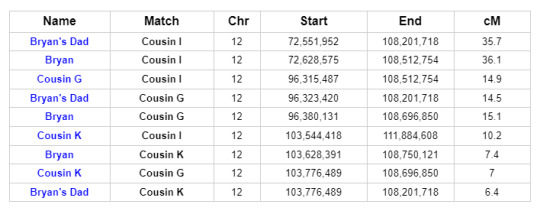
This is what we call a Triangulation Group. It brings the possible genetic connections into sharper focus.
The common segment shared by all of the members of this Triangulation Group indicates that they all share a common ancestor. And we’ve already identified shared ancestry through the Smith line. Cousins I and G are first cousins once removed and they are descendants of Reuben and Mary’s son Charles Thomas Smith...
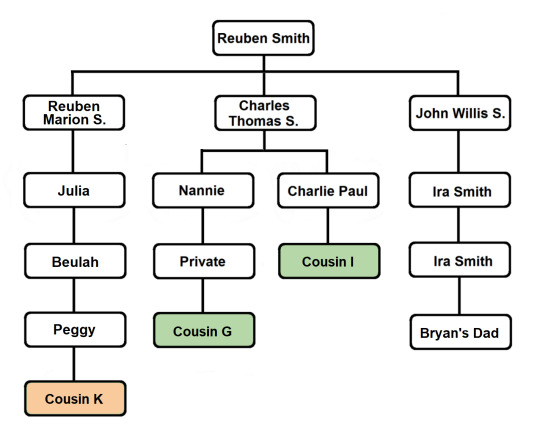
A review of the pedigrees of the matches in question reveals no lines of shared ancestry other than the known shared Smith line. This investigation is summarized briefly in the table below, listing 2nd great grandparent surnames and shared ancestors (blue for paternal names and surnames, light red for maternal names and surnames):
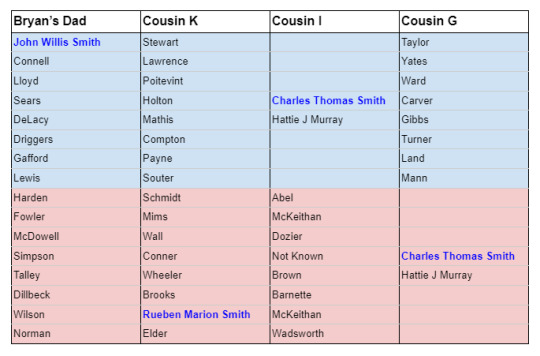
Although we cannot say with perfect certainty that there is no additional common ancestry that conceivably could account for the shared segment of DNA on Chromosome 12, the known evidence doesn’t leave room for much doubt.
For completeness, here’s a chart summarizing the amount of DNA shared by the relatives in question:

And cluster analysis for Cousin G yields a cluster with eight descendants of Reuben Willis Smith, including Bryan Smith and Cousin K:

Not everyone will feel the need to go this far to investigate a 6 cM connection. But this post provides examples of ways to investigate the validity of an ordinary small segment and to determine whether the shared DNA legitimately belongs with the presumed paper trail source of the DNA.
Discussion
Skepticism regarding small segments of shared DNA is appropriate. In comparison to larger shared segments, such segments are more likely to be IBS (false). Additionally, even when small segments can be shown to be reliable, we have to grapple with the fact that small segments can be too old to fall within the reach of reliable historical documentation.
With the exponential growth of the DNA matching databases, the impetus to explore distant matches waned. Reluctance to do the strenuous work involved in using small segments grew. With access to strong genetic connections leading back to target ancestors, why bother with low cM connections?
The sentiment is understandable!
On the other hand, I believe that excessive skepticism has impeded progress in genetic genealogy. As databases have grown, our opportunities for research have multiplied and our research techniques have improved. But at the same time, goalposts for small segment success have been moved to poorly-defined and very unreasonable points.
[From the skeptics: Your success with a small segment doesn’t count if you find a larger segment in a relative! I don’t want to hear about triangulation! Visual phasing is not allowed!]
If we applied such arbitrary restrictions to all areas of genealogy, we’d struggle to get our work done!
Even with our luxuriously large DNA databases, distant genetic connections are the only connections available in some areas of investigation (or to people who hail from less heavily-tested populations). Defeatist refusal to accept low cM matches as evidence in genetic genealogy needlessly limits our potential.
Don’t get me wrong, I’m fully in favor of scholarly rigor. But let’s not allow skepticism to pave the way for denialism!
When distant genetic connections are found to be of dubious quality, they should be set aside. But shared segments should not be judged on the basis of size alone. Even the most fervent opponents of small-segment research will admit that small segments are often valid (IBD). And while these opponents frequently cite IBD/IBS percentages, they ironically fail to see that our ability to find these percentages points directly to a practical method for sorting distant matches on an individual basis.
We are privileged to have access to enormous databases of incredibly valuable genetic information. More than a statistical hiccup that can lead us serendipitously to more reliable information, small DNA segments are messages we carry with us every day, testifying to our connections with our ancestors. Genetic information, even in small amounts, can be just as valuable as any other form of information. We should be good stewards of that information and we should invest good faith effort in understanding how our distant matches can inform us about our rich ancestral history.
I’ll close with this analogy for small segments:
You want some refreshing water but the glass is only half-full. Drink it or toss it out?

Posted with Bryan Smith’s permission. 17 May 2023
#genetic genealogy#DNA testing#DNA#small segments#visual phasing#Triangulation#dna segment#DNA segment triangulation#DNA clustering#clustering#pedigree#family tree#ThruLines
3 notes
·
View notes
Text
genetics is literally so fascinating to me n maybe it’s cause i have like 0 connection to my extended family but there is something so personal about researching your haplogroups… like i am so in love with how me and a bunch of totally different people across a bunch of different countries all share one great great great grandma and even though that was millennia ago we still carry that marker in every cell of our bodies to this day. anyway to all my U7 girlies hello sisters ❤️
#when i say i have no connection to most of my family i mean it like#my dads side made an online family tree included my cousins and parents but left me and my brother out LOL like they just forgot we existed❤#anyway ina few months i can get my brother to do 23andme and then i’ll know my paternal haplogroup im excited!!!#i already have a guess based on the most common y haplogroups of my dna matches + my ethnicity but like#it’d be good to know for sure hehe#oh i also was matched to some guy w my moms maiden name and 23andme says we’re 1st or 2nd cousins but i’ve never heard of this man in my l#life!!! so weird
2 notes
·
View notes
Text
The specter of the genealogist stereotype
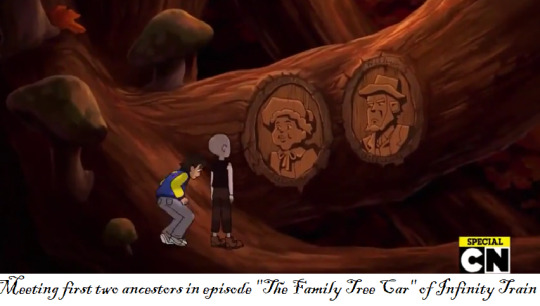
In 1982, Peter Andrews wrote in American Heritage that the "stereotype of the genealogist" has been familiar in popular culture, usually a "specific type, easily recognizable and faintly ridiculous," whether an elderly lady examining musty records or a "retired clergyman supplementing his pension." He adds that this meant that genealogy, itself, "carried an air of quackery about it." However, he says this is no longer the case. This is evident in some series I have written about on this blog before, like Amphibia, Infinity Train, Steven Universe, and throughout the recent reboot of Carmen Sandiego, to name a few posts, apart from last week's post reviewing genealogy in the Outlander series. This is not unique to those series, however. After all, as a podcast, BlackGenProLive, “genealogy and history are en vogue in popular culture, largely due to the number of television programs that are themed around the topics,” and noted in FamilyTree, with The Guardian even saying the current family history boom is due to the internet and TV. [1] Genealogy and family history is widespread in popular culture, with some authors, like Juliette Eames, creating customized children's family history books for people! As Thomas Jay Kemp put it in 2013, "you can find references to genealogy everywhere in America these days."
Reprinted from my Genealogy in Popular Culture WordPress blog. Originally published on April 12, 2021.
John D. Beatty of the Allen County Public Library Genealogy Center wrote in 2018 that genealogists before the 1970s especially only played "incidental roles in eccentric, snobby, or dysfunctional veins." He called the famous satirical painting by Grant Wood, Daughters of Revolution, criticizing the Daughters of the American Revolution (DAR), one of the first "artistic depictions of genealogists," and noted a few other examples prior to the 1970s:
In the 1942 film Castle in the Desert, Professor Gleason, a genealogist with a "moustache and walking stick," arrives at a a mansion of another affuelent man, and he is introduced as a genealogist who will “tell us about the monkeys in our family trees.” He later inquires about a notorious family and the wife of the affulent man gives him a warning, and he died after drinking a cocktail. The message of this film for such a superficial portrayal of a genealogist, is that genealogy is "something that only interested the upper classes and involved the lineages of famous families."
In a 1961 episode of the The Andy Griffith Show, “A Plaque for Mayberry," a town mayor summons a sheriff and his deputy, where they meet two elegantly dressed ladies of a Women’s Historical Society, declaring that they are "attempting to trace the descendant of a Revolutionary War hero, Nathan Tibbs, who had played a pivotal role at the Incident of Mayberry Bridge," which supposedly turned the tide of the war, wanting access to town records. Ultimately, while the genealoists serve only as incidental characters, the view of genealogical research as "a blue-blooded occupation and those who pursue it do so only to find links to prominent forebears" is communicated once more.
In a 1969 film, On Her Majesty’s Secret Service, James Bond goes undercover as a genealogist in order to "investigate Blofeld’s claims of nobility," and it again promotes a view of "genealogists as effete elitists, a campy profession that attracted only eccentrics."
In a 1969 comedy-drama, The Sterile Cuckoo, Pookie Adams is not a genealogist, but loves cemeteries, taking her boyfriend to a graveyard, extoling the "ability to find stories of the departed by reading their epitaphs." Beatty suggests that this shows that "cemeteries were not places that psychologically-healthy people ever visited."
youtube
After 1970, Beatty specifically holds up Roots as shattering the "notion that genealogy was only for the blue-blooded," and says that Alex Haley "embodied a sense of normalcy that had eluded earlier caricatures of genealogists." This is much better than the "magical quality" displayed in Harry Potter and the Order of the Phoenix by transphobic J.K. Rowling, with genealogy not explored at length in the film, none of the characters as genealogists, and the family genealogy is only a minor plot device. Contrast this with the controversial film, The Da Vinci Code, in 2006, where genealogical research plays a key role in the film itself,and various popular television shows [2] where ordinary ancestors are discussed. Even though research is often minimized, Beatty argues that these shows "provide some insight into research methodology." He concludes his article by saying that new portrayals reflect a change in genealogy over time, including further professionalization and democratization which makes it more available to the masses, even while he acknowledges no one should expect genealogists to become "commonplace on the silver screen" even if they show up more in television. He then hopes for complex and diverse genealogical characters in the future which are devoid of stereotypes and are problem-solvers.
Not accounting for documentaries with family history themes, like Children of the Inquisition, Birthplace, and August: Osage County as pointed out by Esther of MyHeritage, Helen, in an undated post on her genealogy blog, gives a few examples of genetic genealogy in popular culture:
The TV series Shameless. In a 2011 episode, "Nana Gallagher Had an Affair," an estranged mother tried to get custody of her son, but finds out that her ex-husband, Frank, is the biological father. In a 2016 episode "Own Your Shit," a brother takes another ancestry DNA test, showing that Carl is "part Native American, specifically Apache, securing him a reserved place." Then there's the 2017 episode "Got Bless Her Rotting Soul," where a family friend takes a DNA screening test, finding a "rare chromosomal pattern" which belongs to a fictional, and isolated, community in rural Kentucky.
In a 2018 episodes of the series, A Discovery of Witches, there is a study of genetics of various species, like demons, witches, and vampires, including an explanation of mitochondrial DNA
In a 2018 episode of the series, Bull, "The Missing Piece," a team assists a man after police identify him as a suspect using "investigative genetic genealogy via a match in a for-profit genetic genealogy company's customer database," and he finds out that he was adopted and had an identical twin brother, with the revelation of a twin brother resulting "in all charges against him being dropped."
In a 2018 episode of Blue Bloods, "Thicker Than Water," two detectives investigate an attempted murder after a daughter discovers, using a consumer DNA test that "the doctor is her biological father." Oh no, what a shock! In a later episode of Blue Bloods, "Family Secrets," in 2020, one character is puzzled by an "unknown first cousin match on his paternal side when he does a consumer DNA test for a school assignment."
In the series Grey's Anatomy, there is an episode in 2019, "Blood and Water," where a doctor orders a DNA test to "overcome her fears about her unknown genetic heritage when feeling pressured to have children." In another 2019 episode, "And Dream of Sheep," a co-worker is able to identify the birth mother of his friend using a "first cousin DNA match."
In a 2019 episode of The Good Fight, "The One where a Nazi Gets Punched," a law firm represents plaintiffs in a lawsuit against a "direct-to-consumer (DTC) genetic testing company."
In a 2019 episode of Nancy Drew, "The Hidden Staircase," a co-worker whips out a DNA test from her lock, asking her long-lost cousin for "some of his saliva for a DNA comparison to help her uncover her mother's mysterious past."
In a 2020 episode of Stumptown, "The Past and the Furious," a former marine and current PI, is hired to track down the birth parents of an adoptee.
In a 2020 episode of Vera, "Parent Not Expected," a DCI investigates the death of a young man who had recently found, through a DNA test, that "the man who raised him was not his biological father," with the admin of an online genealogy forum helping people identify their biological fathers.
"The laws governing inheritance are quite unknown; no one can say why the same peculiarity in different individuals of the same species, and in individuals of different species, is sometimes inherited and sometimes not so; why the child often reverts in certain characters to its grandfather or grandmother or other much more remote ancestor; why a peculiarity is often transmitted from one sex to both sexes, or to one sex alone, more commonly but not exclusively to the like sex"- Chapter 1 of The Origin of the Species
On a related note, in 2013, Daisy Hildyard in The Guardian listed ten literary works about ancestors, specifically pointing to Jerusalem by Jez Butterworth, "This Be the Verse" by Philip Larkin, The Rainbow by DH Lawrence, Bleak House by Charles Dickens, On the Origin of Species by Charles Darwin, "The Eternity of Nature" by John Clare, Brief Lives by John Aubrey, Henry IV Part I by William Shakespeare, Chronicles by Holinshed, and The Bible. Family history themes are even more widespread than this, however. Noel Murray, in 2015, talked about nine films focusing on family secrets, specifically Little White Lie, Secrets & Lies, A Family Thing, Lone Star, Siskel & Ebert, Capturing the Friedmans, The Celebration, Ida, Daughter from Danang, My Architect, and Stories We Tell. Others have written about genealogy in the realm of theater, of which were are various examples, [3] or noted some of the "most insane families in anime." On the latter, in a post for the Anime News Network, Gia Manry mentioned:
Arcana Famiglia (La storia della Arcana Famiglia), a mafia-style family
The Rozen Maidens (Rozen Maiden), sister dolls
The Ushiromiya Family (Umineko no Naku Koro ni), a huge clan
The Matou Family (Fate/stay night), creators of a system that serves as a central conflict throughout the franchise as a whole
Eastern Europe (Hetalia), composed of personified nations
Britannian Royal Family (Code Geass), has a family history "chock-full of colorful characters, political intrigue, and outrageous deaths"
The Hair Siblings (Bobobo-bo Bo-bobo), siblings fighting over their inheritance to the Hair Kingdom and are totally bonkers
The Ikari Family (Neon Genesis Evangelion), a clan which has a lot of internal family problems
Some others, like BYU Family History, lists family history themes in the White supremacist Back to the Future, and other films, like Lion King, Holes, Star Wars, My Big Fat Greek Wedding, Hitch, and Mulan. As one genealogist put it, "genealogy has changed; but yet it has not," with genealogists continuing to seek out "records hidden in courthouse attics and basements."
© 2021-2023 Burkely Hermann. All rights reserved.
Notes
[1] There may be some reviews of popular culture in Christine Scodari’s book Alternate Roots: Ethnicity, Race, and Identity in Genealogy Media, although I’m not sure. But I'll try to get the book and let you know what I think, writing about it on here.
[2] Like Who Do You Think You Are, Genealogy Roadshow, and Finding Your Roots. Some scholars have criticized what they call "selective rememberance" on these TV shows.
[3] In one post, Sydney Orton,talks about family history themes in Ragtime, Bandstand, The Pirate Queen, Miss Saigon, Finding Neverland, Evita, Bonnie & Clyde, Fiddler on the Roof, and Big River. In another post, she focuses on similar themes in Come From Away, 1776, Allegiance, Anastasia, 9 to 5, Les Miserables, Newsies, A Tale of Two Cities, Bright Star, Memphis, West Side Story, Titanic: The Musical, The Sound of Music, and The Civil War.
#amphibia#infinity train#outlander#steven universe#carmen sandiego#the guardian#family trees#ancestors#genealogy#dar#harry potter#jk rowling#transphobia#roots tv show#anime#anime news network#Youtube#dna#dna testing#family history#roots work
9 notes
·
View notes
Text
I watched a video about Victorian medicine and it mentioned a Dr. John Snow and I remembered my dad mentioning that we maybe related to a doctor who took care of the King or who was a doctor(he couldn't remember it EXACTLY). Doing as much research as I could on the guy tho it seems like John didn't have any kids but he had eight siblings. Could be likely we come from any of those siblings(I wanna look into them too lol). Either way, the thought of possibly being related to the guy, even like super distantly, who located the source of the cholera outbreak is kind of neat in a weird way but then again I like weird obscure history facts anyway. Either way it's fucking cool lmao
#at least *I* think its cool#i wanna get my ancestry done tho try and see my family tree#but i wanna do it without dna bc the government#talkies
2 notes
·
View notes